Your brand new artificial turf looks flat and disappointing? Without a solid foundation, your investment won’t last. The secret to a perfect lawn is often the sand infill.
Sand infill is essential for most artificial grass installations. It adds weight to secure the turf, helps the grass fibers stand upright for a natural look, protects the backing from sun damage, improves drainage, and increases the longevity of your investment.
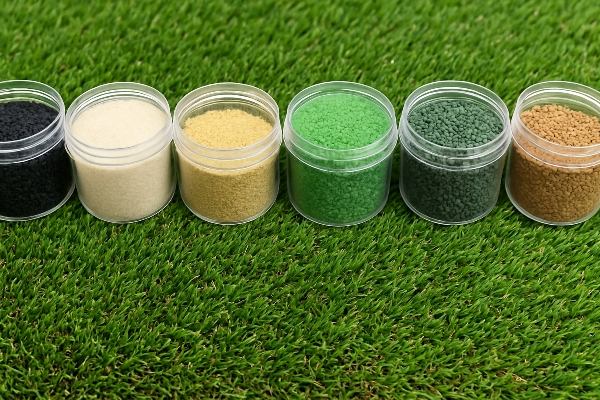
This might sound simple, but getting it right involves more than just throwing sand on your lawn. Using the wrong type of sand or applying it incorrectly can cause problems. I’ve seen this happen before. One of my first clients tried to save money by skipping the infill on a small project. Within a year, the turf had developed wrinkles and the fibers were completely flat. They had to pay to have it fixed properly. Let’s make sure you understand the details so you get it right the first time and avoid costly mistakes.
What Are the Benefits of Using Sand Infill?
Thinking sand is just an optional extra? You might be missing out on a key component for a long-lasting turf installation. Without it, your grass could fail prematurely.
The main benefits of sand infill are stability1, aesthetics2, and durability3. It anchors the turf, keeps grass blades upright, protects the base from sun damage, improves drainage, and adds a fire-resistant layer for extra safety.
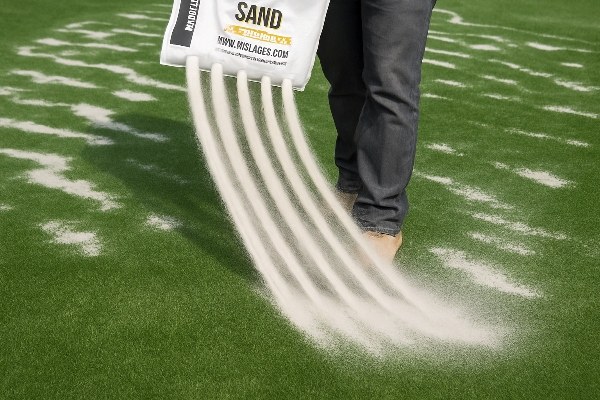
When I first started in this industry, I worked in the factory’s technical department. I saw firsthand how much engineering goes into creating durable turf. But all that work can be wasted if the installation isn’t done right. Sand infill is the critical final touch that brings the whole system together. It’s not just loose sand; it’s an integral part of the turf system. Here is a deeper look at why it’s so important.
Supporting the Grass Blades
The most visible benefit is how sand helps the artificial grass blades stand up. The sand particles sit at the base of the fibers, providing support. This makes the lawn look much more like natural grass. It also helps the blades bounce back after being walked on, which is a sign of a quality installation.
Protecting the Turf Backing
The primary backing of the turf is what holds everything together. However, it can be vulnerable to direct sunlight and UV radiation over time. Sand infill creates a protective layer over the backing. This simple barrier shields it from the sun, preventing it from becoming brittle and breaking down. This significantly extends the life of your turf.
Adding Weight and Stability
A roll of artificial grass is heavy, but it’s not heavy enough to stay perfectly flat on its own. Temperature changes can cause it to expand and contract, leading to wrinkles or movement. Sand infill adds a significant amount of weight across the entire surface. This ballast holds the turf securely in place, preventing any shifting and ensuring it lays flat for years.
| Benefit | Detailed Explanation |
|---|---|
| Blade Support | It supports the base of the grass fibers, helping them stand upright and return to position after being walked on. |
| Durability | It protects the primary backing from direct UV exposure and foot traffic, which significantly extends the turf’s life. |
| Stability | Sand adds weight, preventing the turf from shifting, wrinkling, or lifting at the edges. |
| Safety | It provides ballast and can add a layer of fire resistance, as sand is non-flammable. |
What Are the Disadvantages of Sand Infill?
You heard sand is essential, but are there any downsides? Choosing the wrong type or using an incorrect method can create new problems, like a hard surface or poor drainage.
The main disadvantages can include the surface feeling harder, potential for compaction over time which can reduce drainage, and the possibility of weed growth if organic material mixes in. It can also get quite hot.
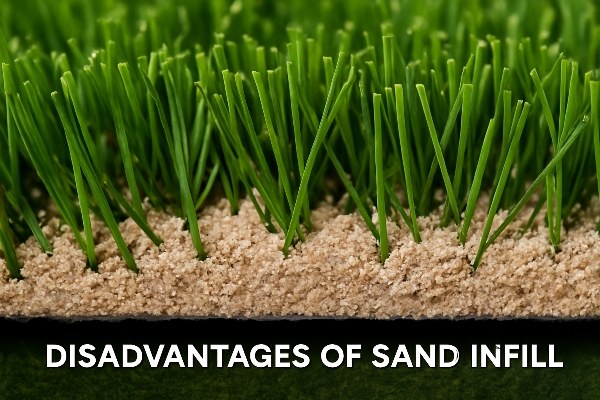
While I almost always recommend sand infill, it’s important for my clients to understand the potential drawbacks so they can be managed. A customer in a very hot region once called me concerned about the surface temperature of their new pitch. We discussed the type of infill used—a standard silica sand—and realized a different type, or a blend, might have been better for his climate. Being aware of these issues beforehand helps you make the best choice for your specific project. Let’s look at some of these potential issues.
Compaction Over Time
In high-traffic areas, sand infill can gradually compact. The small grains of sand press together, creating a harder surface. This can make the lawn less comfortable to walk or play on. More importantly, heavy compaction can reduce the turf’s permeability. This means water may not drain through as effectively as it should, potentially leading to puddles on the surface after heavy rain. Regular brushing can help prevent this.
Heat Retention
Sand, particularly standard silica sand, has a tendency to absorb and hold onto heat. On hot, sunny days, this can cause the surface of the artificial grass to become very warm to the touch. This can be a concern for families with children or pets. Using coated or rounded sands, or lightly spraying the turf with water, can help manage the temperature.
Potential for Weeds
While artificial turf is low-maintenance, it’s not "no-maintenance." If leaves, dirt, and other organic matter are allowed to build up on the surface, they can create a shallow layer on top of the sand where airborne seeds can germinate. These weeds are typically easy to remove because their roots cannot penetrate the turf backing, but it’s something to be aware of.
How Do You Install Sand Infill On Your Artificial Grass Turf?
Your turf is laid out, but it’s not finished yet. Applying the infill incorrectly can ruin all your hard work. Getting it right is crucial for a professional, long-lasting result.
First, ensure the turf is completely dry. Use a drop spreader to apply the sand evenly. After applying a layer, use a power broom or stiff-bristled broom to brush the sand down into the base of the fibers.
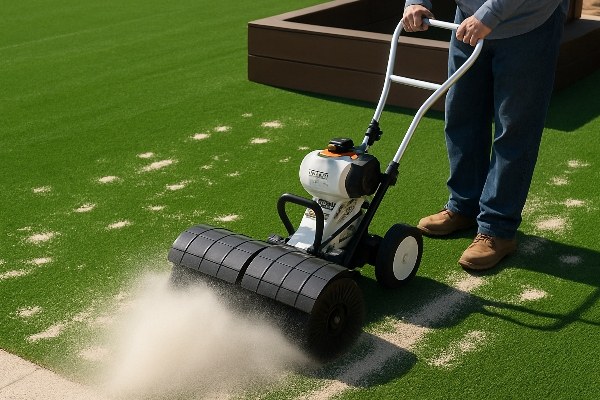
I can’t stress this enough: the installation process for infill is just as important as the infill itself. I once saw an installation crew try to save time by spreading the sand while the grass was still damp from morning dew. The sand clumped together, creating an uneven mess that was impossible to fix. They had to use industrial vacuums to remove it all and start over. It was a costly lesson in trying to cut corners. Follow these steps to avoid that headache.
Step 1: Prepare the Surface
Before you even open a bag of sand, make sure the artificial grass is completely dry. Any moisture will cause the sand to clump. Brush the grass fibers with a stiff broom or a power broom so they are standing as upright as possible. This opens up the space between the blades, making it easier for the sand to drop down to the base.
Step 2: Use a Drop Spreader
For an even application, a mechanical drop spreader is your best tool. Do not just dump piles of sand on the turf and try to rake it around. This will create high and low spots. Calibrate your spreader to release the sand at a steady, controlled rate, and walk in consistent, slightly overlapping lines across the entire area.
Step 3: Brush the Sand In
After you’ve applied a thin, even layer of sand, it’s time to work it down into the turf. A power broom is the most efficient tool for this job. It rotates and vibrates, quickly settling the sand to the bottom. If you don’t have a power broom, a stiff-bristled push broom will also work, but it will require much more physical effort. Always brush against the grain of the grass fibers to help them stand up.
Step 4: Repeat in Layers
Don’t apply all the sand at once. The best method is to apply it in several thin layers. Apply one layer, brush it in thoroughly, then apply the next layer. Repeat this process until you have applied the recommended amount of sand for your specific turf. This layering technique ensures the infill is distributed evenly from the bottom up.
How Much Sand Should You Put on Artificial Grass?
Worried about adding too much or too little sand? The wrong amount can make your lawn hard as a rock or leave it looking flat and unstable. There is a sweet spot.
The amount of sand needed depends on the pile height and density of your artificial grass. A common range is 5-15 kg per square meter (1-3 pounds per square foot). Always check the manufacturer’s recommendation for your specific product.
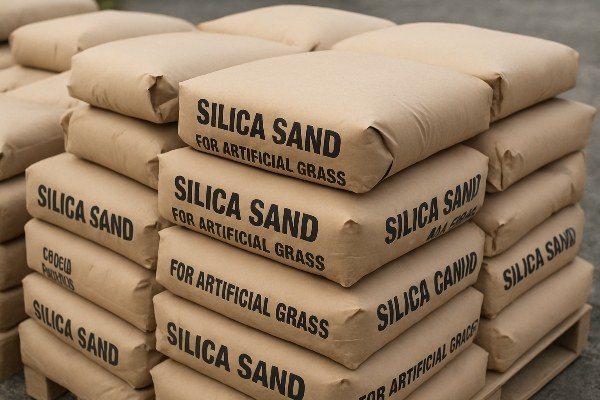
One of the most common questions I get from clients is about the exact quantity of infill. It’s a critical detail. Too little, and you lose the benefits of stability and blade support. Too much, and the grass can feel stiff or buried. The right amount is not a guess; it’s a specification. It depends on the product’s design. This is a detail I always confirm on the technical data sheet before any project starts. Let’s look at the factors that determine the correct amount.
Pile Height is Key
The most important factor is the pile height, which is the length of the grass blades. Taller grass needs more sand to support the longer fibers and provide the necessary weight. Shorter grass needs less. As a general rule, you want the infill to fill between 50% and 75% of the pile height.
Consider Traffic and Use
The intended use of the area also matters. A decorative lawn with very little foot traffic might be fine with a bit less infill. However, a high-traffic area, like a backyard where children play or a commercial space, will need a proper amount of infill to ensure durability and resilience. The infill helps the fibers withstand the constant pressure and spring back up.
A General Guideline
While you must always check the manufacturer’s specifications, here is a general table to give you an idea. The amounts are listed in kilograms per square meter.
| Pile Height | Recommended Sand Infill (per m²) | Notes |
|---|---|---|
| < 25 mm (1 inch) | 5-8 kg | Often used for decorative areas, patios, or putting greens. |
| 25-35 mm (1-1.4 in) | 8-12 kg | The most common range for residential landscape turf. |
| > 35 mm (1.4 in+) | 12-15+ kg | Used for lush, high-end lawns and sports applications. |
Remember, this is just a guide. Your turf supplier must provide a technical data sheet with the exact infill requirement for the product you purchased. Following that specification is the best way to guarantee a successful and long-lasting installation.
Conclusion
Sand infill is not an option; it’s a vital part for the longevity, performance, and appearance of your artificial grass. Getting the amount and installation right ensures a professional result.
_画板-1.png)
_画板-1.png)